Sustainability and Risk Engineering: Urban Land Analysis & Design
VerifiedAdded on 2023/03/30
|34
|5415
|201
Report
AI Summary
This report presents a comprehensive analysis of sustainability and risk engineering applied to a 10ha urban land area. It details the location, climate, and terrain layout of the selected site in Kingaroy, Queensland, Australia. The report outlines the design of a typical residential building adhering to BASIX standards, focusing on water and energy efficiency, and thermal comfort. It includes an estimation of embodied energy using GaBi software, considering construction materials, transportation, and upstream energy. Furthermore, the report estimates the operational energy required for both residential and commercial properties and the total energy needed to sustain the urban center over 50 years. It also addresses water management through the implementation of Water Sensitive Urban Design (WSUD) technologies, including MUSIC modeling for runoff estimation and water balance development. The study concludes with recommendations for ensuring the long-term sustainability of the urban development, emphasizing the importance of resource efficiency and environmental protection. Desklib provides access to similar reports and study tools for students.
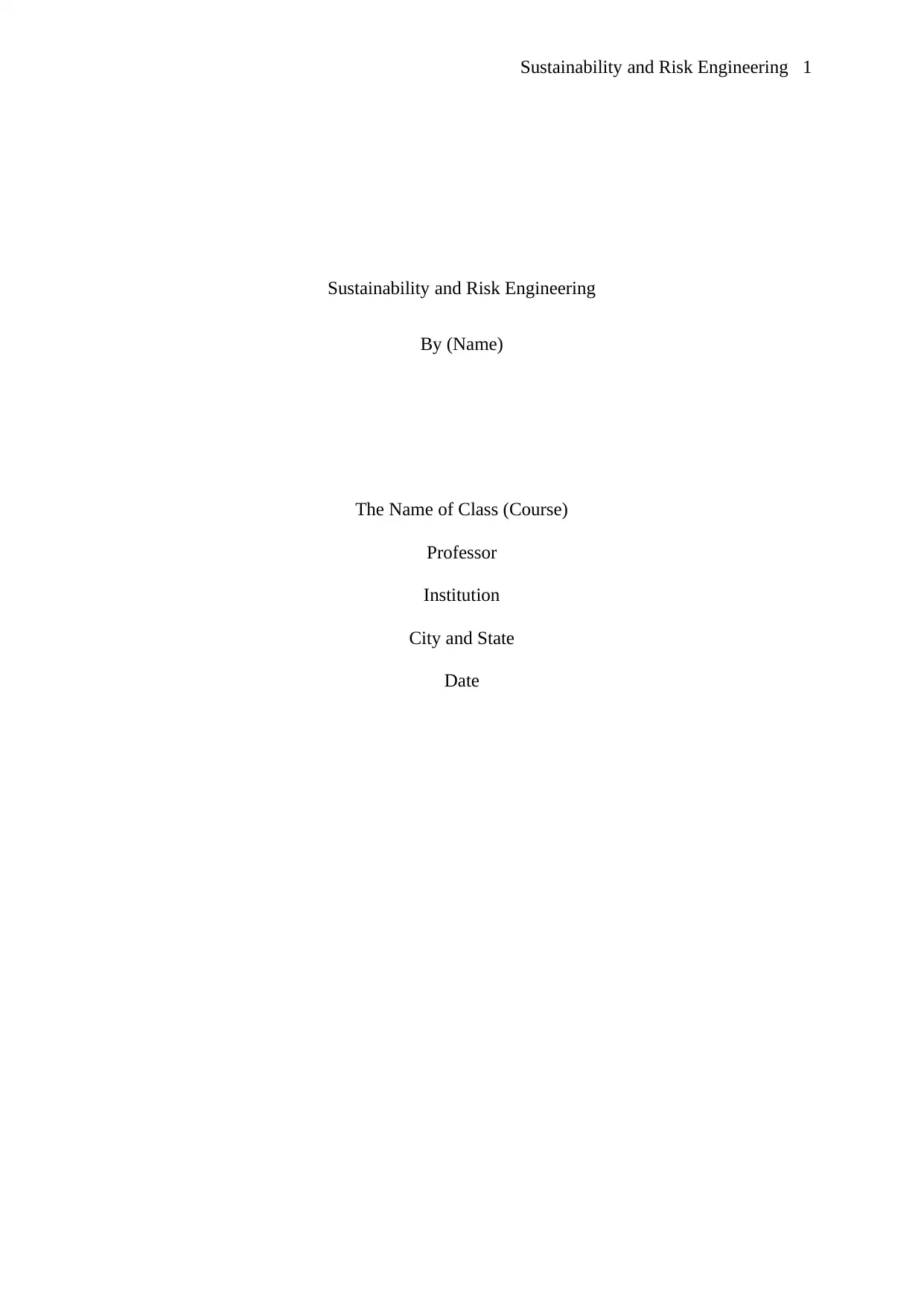
Sustainability and Risk Engineering 1
Sustainability and Risk Engineering
By (Name)
The Name of Class (Course)
Professor
Institution
City and State
Date
Sustainability and Risk Engineering
By (Name)
The Name of Class (Course)
Professor
Institution
City and State
Date
Paraphrase This Document
Need a fresh take? Get an instant paraphrase of this document with our AI Paraphraser
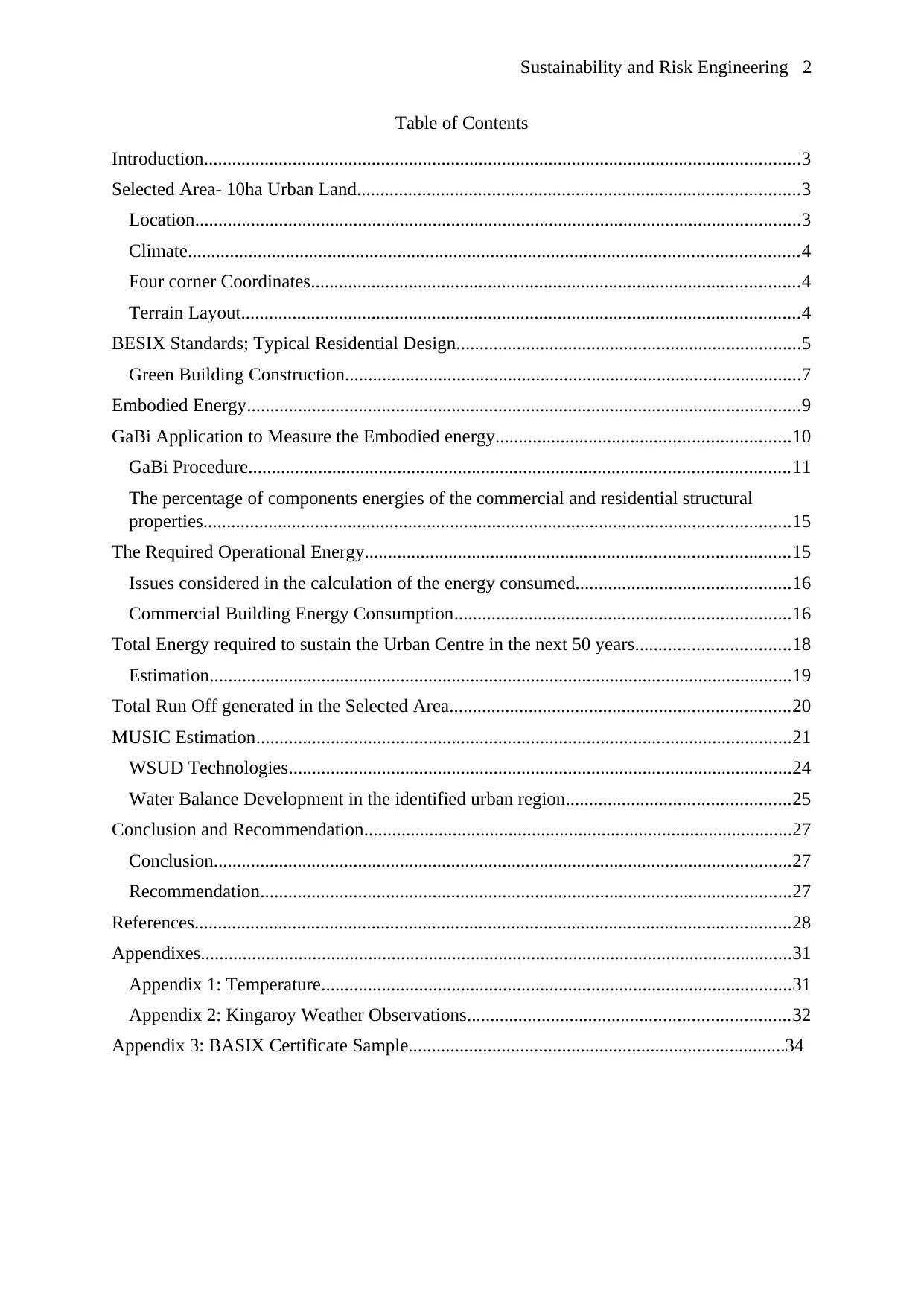
Sustainability and Risk Engineering 2
Table of Contents
Introduction................................................................................................................................3
Selected Area- 10ha Urban Land...............................................................................................3
Location..................................................................................................................................3
Climate...................................................................................................................................4
Four corner Coordinates.........................................................................................................4
Terrain Layout........................................................................................................................4
BESIX Standards; Typical Residential Design..........................................................................5
Green Building Construction..................................................................................................7
Embodied Energy.......................................................................................................................9
GaBi Application to Measure the Embodied energy...............................................................10
GaBi Procedure....................................................................................................................11
The percentage of components energies of the commercial and residential structural
properties..............................................................................................................................15
The Required Operational Energy...........................................................................................15
Issues considered in the calculation of the energy consumed..............................................16
Commercial Building Energy Consumption........................................................................16
Total Energy required to sustain the Urban Centre in the next 50 years.................................18
Estimation.............................................................................................................................19
Total Run Off generated in the Selected Area.........................................................................20
MUSIC Estimation...................................................................................................................21
WSUD Technologies............................................................................................................24
Water Balance Development in the identified urban region................................................25
Conclusion and Recommendation............................................................................................27
Conclusion............................................................................................................................27
Recommendation..................................................................................................................27
References................................................................................................................................28
Appendixes...............................................................................................................................31
Appendix 1: Temperature.....................................................................................................31
Appendix 2: Kingaroy Weather Observations.....................................................................32
Appendix 3: BASIX Certificate Sample.................................................................................34
Table of Contents
Introduction................................................................................................................................3
Selected Area- 10ha Urban Land...............................................................................................3
Location..................................................................................................................................3
Climate...................................................................................................................................4
Four corner Coordinates.........................................................................................................4
Terrain Layout........................................................................................................................4
BESIX Standards; Typical Residential Design..........................................................................5
Green Building Construction..................................................................................................7
Embodied Energy.......................................................................................................................9
GaBi Application to Measure the Embodied energy...............................................................10
GaBi Procedure....................................................................................................................11
The percentage of components energies of the commercial and residential structural
properties..............................................................................................................................15
The Required Operational Energy...........................................................................................15
Issues considered in the calculation of the energy consumed..............................................16
Commercial Building Energy Consumption........................................................................16
Total Energy required to sustain the Urban Centre in the next 50 years.................................18
Estimation.............................................................................................................................19
Total Run Off generated in the Selected Area.........................................................................20
MUSIC Estimation...................................................................................................................21
WSUD Technologies............................................................................................................24
Water Balance Development in the identified urban region................................................25
Conclusion and Recommendation............................................................................................27
Conclusion............................................................................................................................27
Recommendation..................................................................................................................27
References................................................................................................................................28
Appendixes...............................................................................................................................31
Appendix 1: Temperature.....................................................................................................31
Appendix 2: Kingaroy Weather Observations.....................................................................32
Appendix 3: BASIX Certificate Sample.................................................................................34
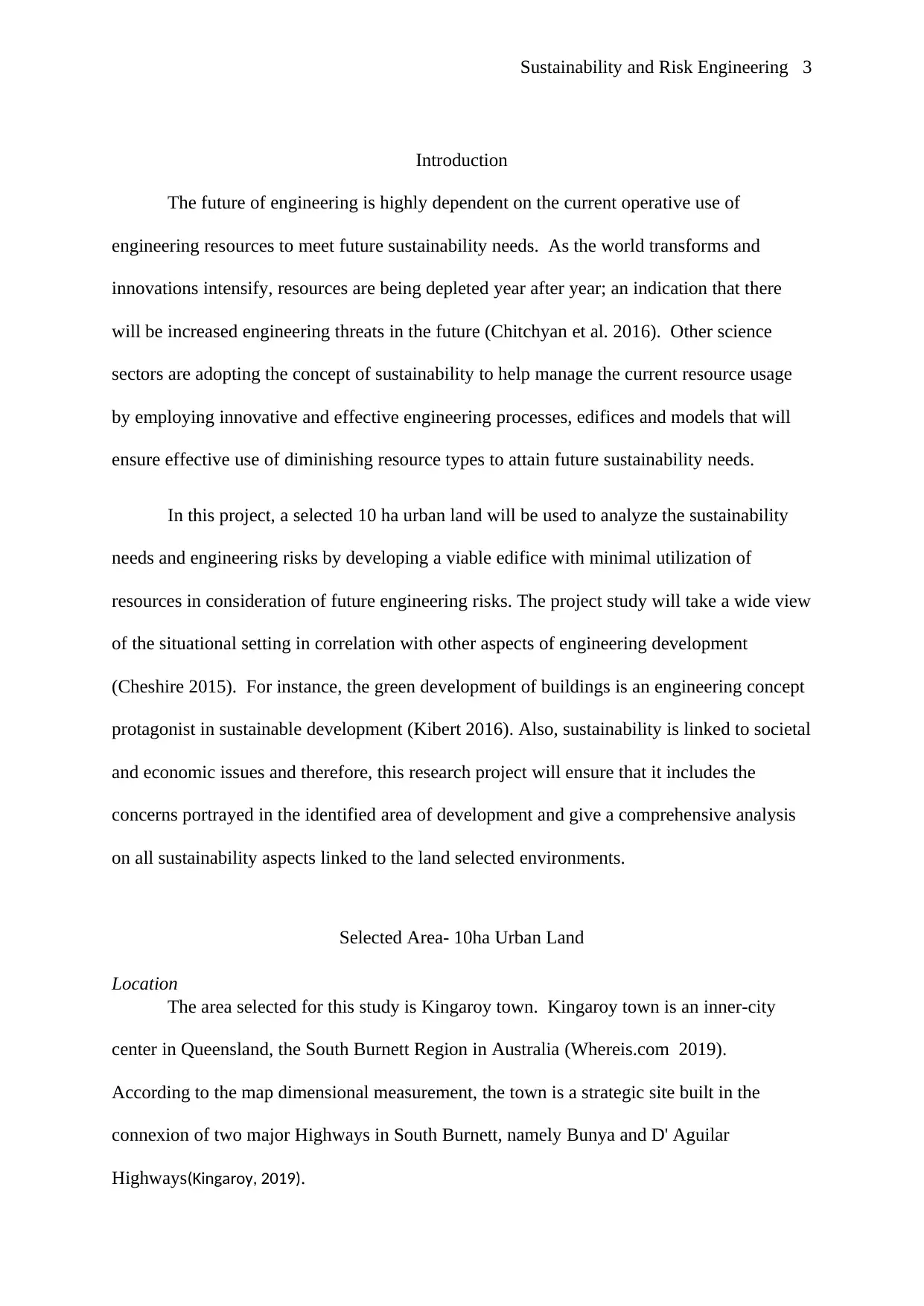
Sustainability and Risk Engineering 3
Introduction
The future of engineering is highly dependent on the current operative use of
engineering resources to meet future sustainability needs. As the world transforms and
innovations intensify, resources are being depleted year after year; an indication that there
will be increased engineering threats in the future (Chitchyan et al. 2016). Other science
sectors are adopting the concept of sustainability to help manage the current resource usage
by employing innovative and effective engineering processes, edifices and models that will
ensure effective use of diminishing resource types to attain future sustainability needs.
In this project, a selected 10 ha urban land will be used to analyze the sustainability
needs and engineering risks by developing a viable edifice with minimal utilization of
resources in consideration of future engineering risks. The project study will take a wide view
of the situational setting in correlation with other aspects of engineering development
(Cheshire 2015). For instance, the green development of buildings is an engineering concept
protagonist in sustainable development (Kibert 2016). Also, sustainability is linked to societal
and economic issues and therefore, this research project will ensure that it includes the
concerns portrayed in the identified area of development and give a comprehensive analysis
on all sustainability aspects linked to the land selected environments.
Selected Area- 10ha Urban Land
Location
The area selected for this study is Kingaroy town. Kingaroy town is an inner-city
center in Queensland, the South Burnett Region in Australia (Whereis.com 2019).
According to the map dimensional measurement, the town is a strategic site built in the
connexion of two major Highways in South Burnett, namely Bunya and D' Aguilar
Highways(Kingaroy, 2019).
Introduction
The future of engineering is highly dependent on the current operative use of
engineering resources to meet future sustainability needs. As the world transforms and
innovations intensify, resources are being depleted year after year; an indication that there
will be increased engineering threats in the future (Chitchyan et al. 2016). Other science
sectors are adopting the concept of sustainability to help manage the current resource usage
by employing innovative and effective engineering processes, edifices and models that will
ensure effective use of diminishing resource types to attain future sustainability needs.
In this project, a selected 10 ha urban land will be used to analyze the sustainability
needs and engineering risks by developing a viable edifice with minimal utilization of
resources in consideration of future engineering risks. The project study will take a wide view
of the situational setting in correlation with other aspects of engineering development
(Cheshire 2015). For instance, the green development of buildings is an engineering concept
protagonist in sustainable development (Kibert 2016). Also, sustainability is linked to societal
and economic issues and therefore, this research project will ensure that it includes the
concerns portrayed in the identified area of development and give a comprehensive analysis
on all sustainability aspects linked to the land selected environments.
Selected Area- 10ha Urban Land
Location
The area selected for this study is Kingaroy town. Kingaroy town is an inner-city
center in Queensland, the South Burnett Region in Australia (Whereis.com 2019).
According to the map dimensional measurement, the town is a strategic site built in the
connexion of two major Highways in South Burnett, namely Bunya and D' Aguilar
Highways(Kingaroy, 2019).
⊘ This is a preview!⊘
Do you want full access?
Subscribe today to unlock all pages.

Trusted by 1+ million students worldwide
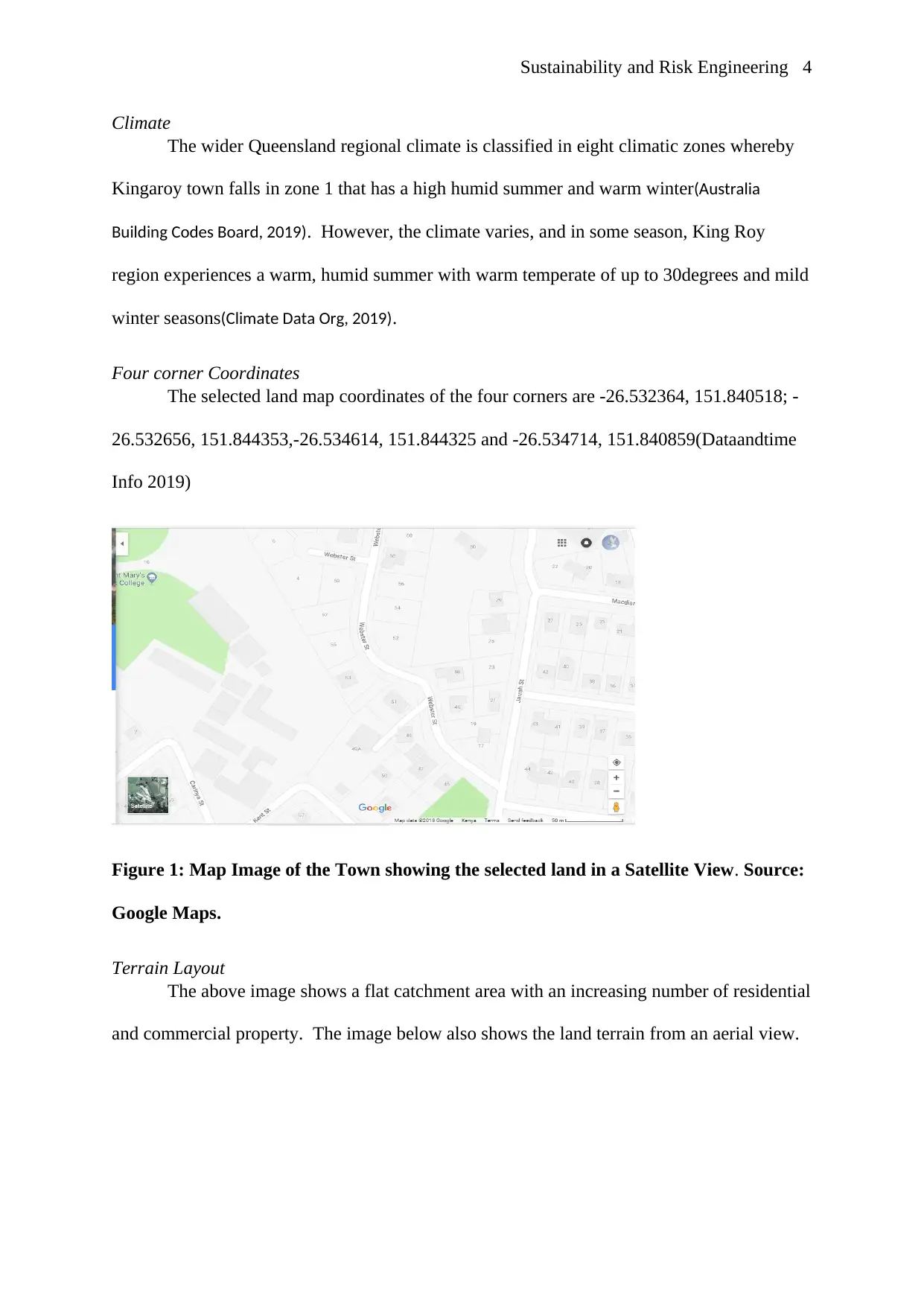
Sustainability and Risk Engineering 4
Climate
The wider Queensland regional climate is classified in eight climatic zones whereby
Kingaroy town falls in zone 1 that has a high humid summer and warm winter(Australia
Building Codes Board, 2019). However, the climate varies, and in some season, King Roy
region experiences a warm, humid summer with warm temperate of up to 30degrees and mild
winter seasons(Climate Data Org, 2019).
Four corner Coordinates
The selected land map coordinates of the four corners are -26.532364, 151.840518; -
26.532656, 151.844353,-26.534614, 151.844325 and -26.534714, 151.840859(Dataandtime
Info 2019)
Figure 1: Map Image of the Town showing the selected land in a Satellite View. Source:
Google Maps.
Terrain Layout
The above image shows a flat catchment area with an increasing number of residential
and commercial property. The image below also shows the land terrain from an aerial view.
Climate
The wider Queensland regional climate is classified in eight climatic zones whereby
Kingaroy town falls in zone 1 that has a high humid summer and warm winter(Australia
Building Codes Board, 2019). However, the climate varies, and in some season, King Roy
region experiences a warm, humid summer with warm temperate of up to 30degrees and mild
winter seasons(Climate Data Org, 2019).
Four corner Coordinates
The selected land map coordinates of the four corners are -26.532364, 151.840518; -
26.532656, 151.844353,-26.534614, 151.844325 and -26.534714, 151.840859(Dataandtime
Info 2019)
Figure 1: Map Image of the Town showing the selected land in a Satellite View. Source:
Google Maps.
Terrain Layout
The above image shows a flat catchment area with an increasing number of residential
and commercial property. The image below also shows the land terrain from an aerial view.
Paraphrase This Document
Need a fresh take? Get an instant paraphrase of this document with our AI Paraphraser
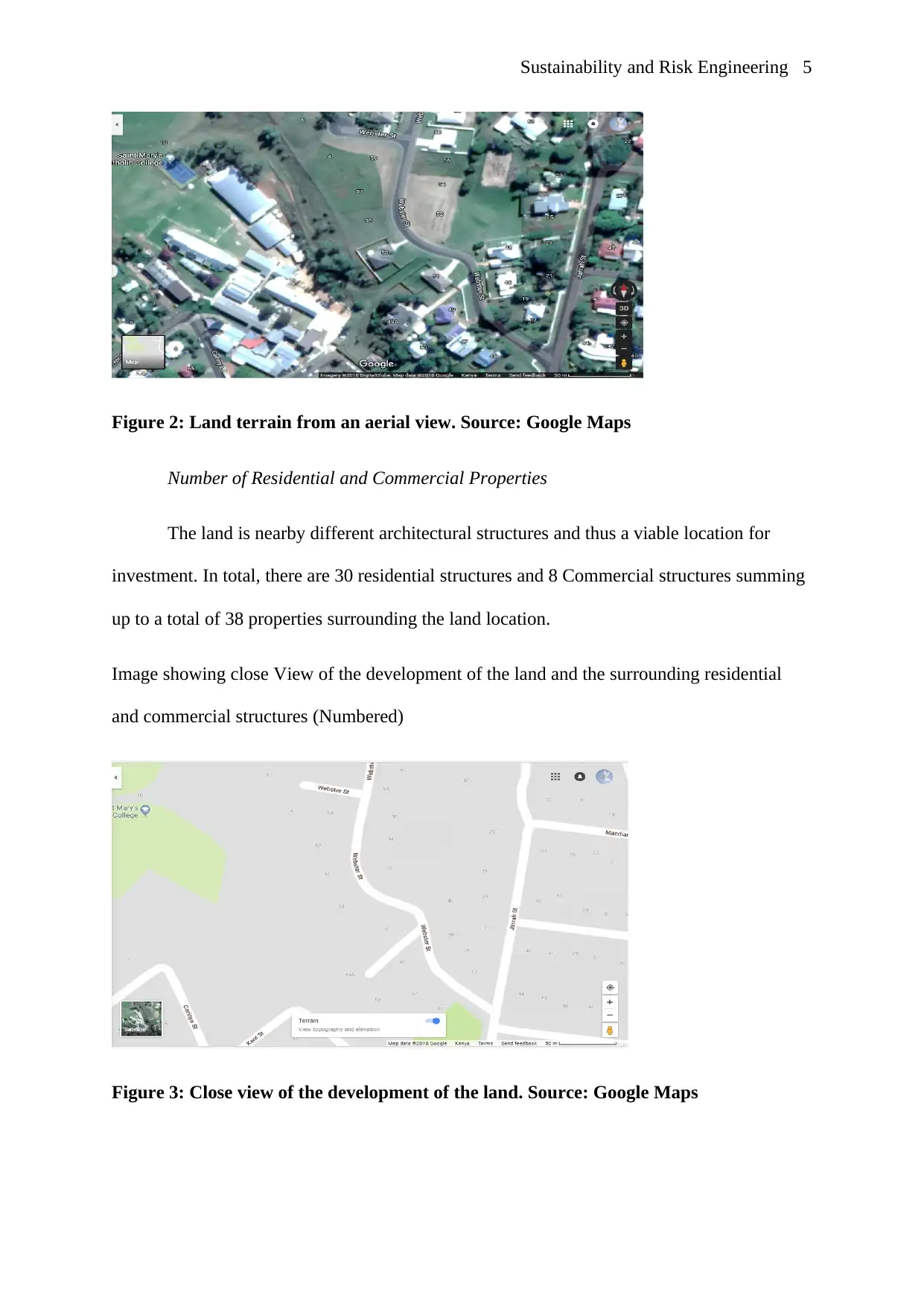
Sustainability and Risk Engineering 5
Figure 2: Land terrain from an aerial view. Source: Google Maps
Number of Residential and Commercial Properties
The land is nearby different architectural structures and thus a viable location for
investment. In total, there are 30 residential structures and 8 Commercial structures summing
up to a total of 38 properties surrounding the land location.
Image showing close View of the development of the land and the surrounding residential
and commercial structures (Numbered)
Figure 3: Close view of the development of the land. Source: Google Maps
Figure 2: Land terrain from an aerial view. Source: Google Maps
Number of Residential and Commercial Properties
The land is nearby different architectural structures and thus a viable location for
investment. In total, there are 30 residential structures and 8 Commercial structures summing
up to a total of 38 properties surrounding the land location.
Image showing close View of the development of the land and the surrounding residential
and commercial structures (Numbered)
Figure 3: Close view of the development of the land. Source: Google Maps
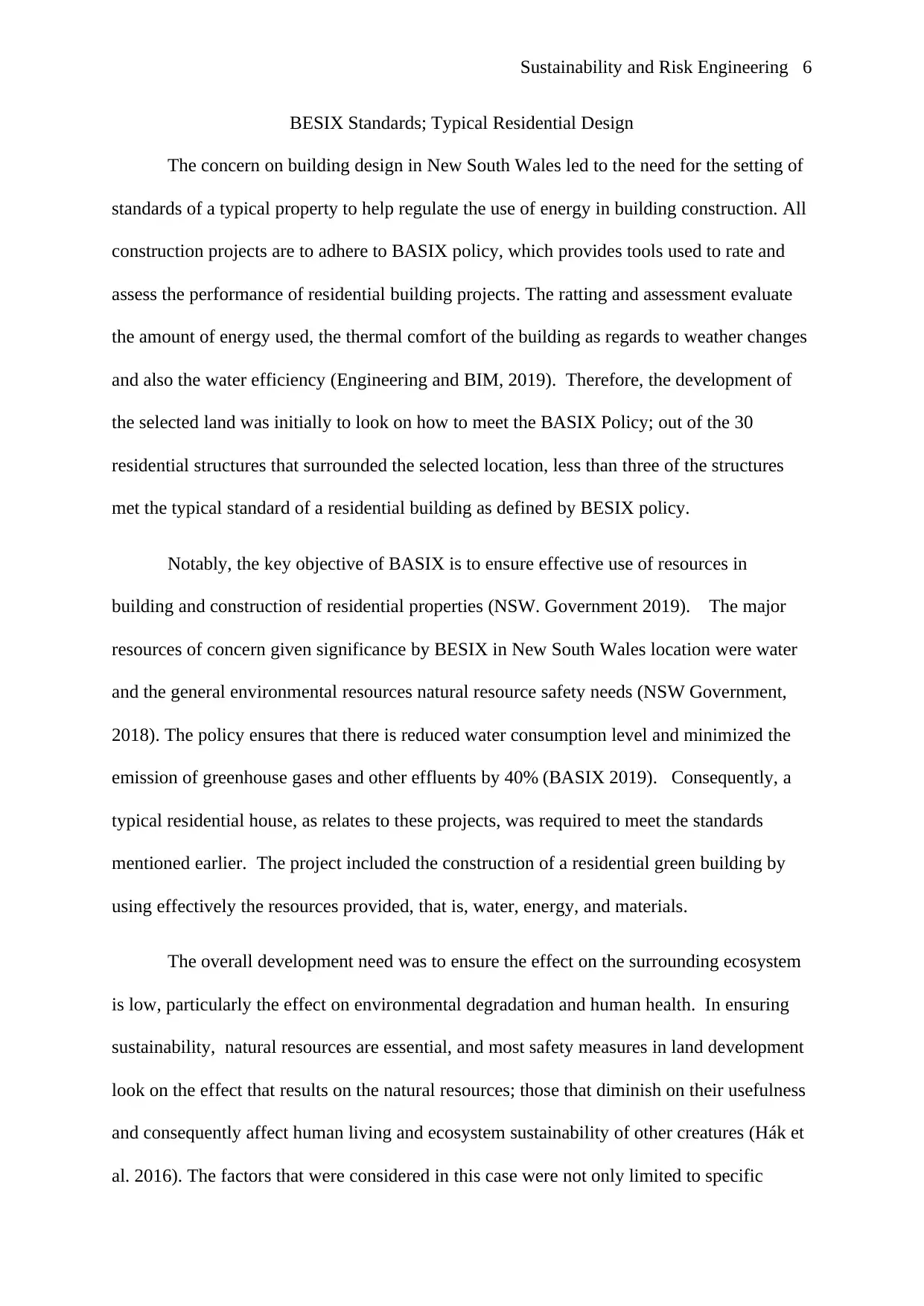
Sustainability and Risk Engineering 6
BESIX Standards; Typical Residential Design
The concern on building design in New South Wales led to the need for the setting of
standards of a typical property to help regulate the use of energy in building construction. All
construction projects are to adhere to BASIX policy, which provides tools used to rate and
assess the performance of residential building projects. The ratting and assessment evaluate
the amount of energy used, the thermal comfort of the building as regards to weather changes
and also the water efficiency (Engineering and BIM, 2019). Therefore, the development of
the selected land was initially to look on how to meet the BASIX Policy; out of the 30
residential structures that surrounded the selected location, less than three of the structures
met the typical standard of a residential building as defined by BESIX policy.
Notably, the key objective of BASIX is to ensure effective use of resources in
building and construction of residential properties (NSW. Government 2019). The major
resources of concern given significance by BESIX in New South Wales location were water
and the general environmental resources natural resource safety needs (NSW Government,
2018). The policy ensures that there is reduced water consumption level and minimized the
emission of greenhouse gases and other effluents by 40% (BASIX 2019). Consequently, a
typical residential house, as relates to these projects, was required to meet the standards
mentioned earlier. The project included the construction of a residential green building by
using effectively the resources provided, that is, water, energy, and materials.
The overall development need was to ensure the effect on the surrounding ecosystem
is low, particularly the effect on environmental degradation and human health. In ensuring
sustainability, natural resources are essential, and most safety measures in land development
look on the effect that results on the natural resources; those that diminish on their usefulness
and consequently affect human living and ecosystem sustainability of other creatures (Hák et
al. 2016). The factors that were considered in this case were not only limited to specific
BESIX Standards; Typical Residential Design
The concern on building design in New South Wales led to the need for the setting of
standards of a typical property to help regulate the use of energy in building construction. All
construction projects are to adhere to BASIX policy, which provides tools used to rate and
assess the performance of residential building projects. The ratting and assessment evaluate
the amount of energy used, the thermal comfort of the building as regards to weather changes
and also the water efficiency (Engineering and BIM, 2019). Therefore, the development of
the selected land was initially to look on how to meet the BASIX Policy; out of the 30
residential structures that surrounded the selected location, less than three of the structures
met the typical standard of a residential building as defined by BESIX policy.
Notably, the key objective of BASIX is to ensure effective use of resources in
building and construction of residential properties (NSW. Government 2019). The major
resources of concern given significance by BESIX in New South Wales location were water
and the general environmental resources natural resource safety needs (NSW Government,
2018). The policy ensures that there is reduced water consumption level and minimized the
emission of greenhouse gases and other effluents by 40% (BASIX 2019). Consequently, a
typical residential house, as relates to these projects, was required to meet the standards
mentioned earlier. The project included the construction of a residential green building by
using effectively the resources provided, that is, water, energy, and materials.
The overall development need was to ensure the effect on the surrounding ecosystem
is low, particularly the effect on environmental degradation and human health. In ensuring
sustainability, natural resources are essential, and most safety measures in land development
look on the effect that results on the natural resources; those that diminish on their usefulness
and consequently affect human living and ecosystem sustainability of other creatures (Hák et
al. 2016). The factors that were considered in this case were not only limited to specific
⊘ This is a preview!⊘
Do you want full access?
Subscribe today to unlock all pages.

Trusted by 1+ million students worldwide
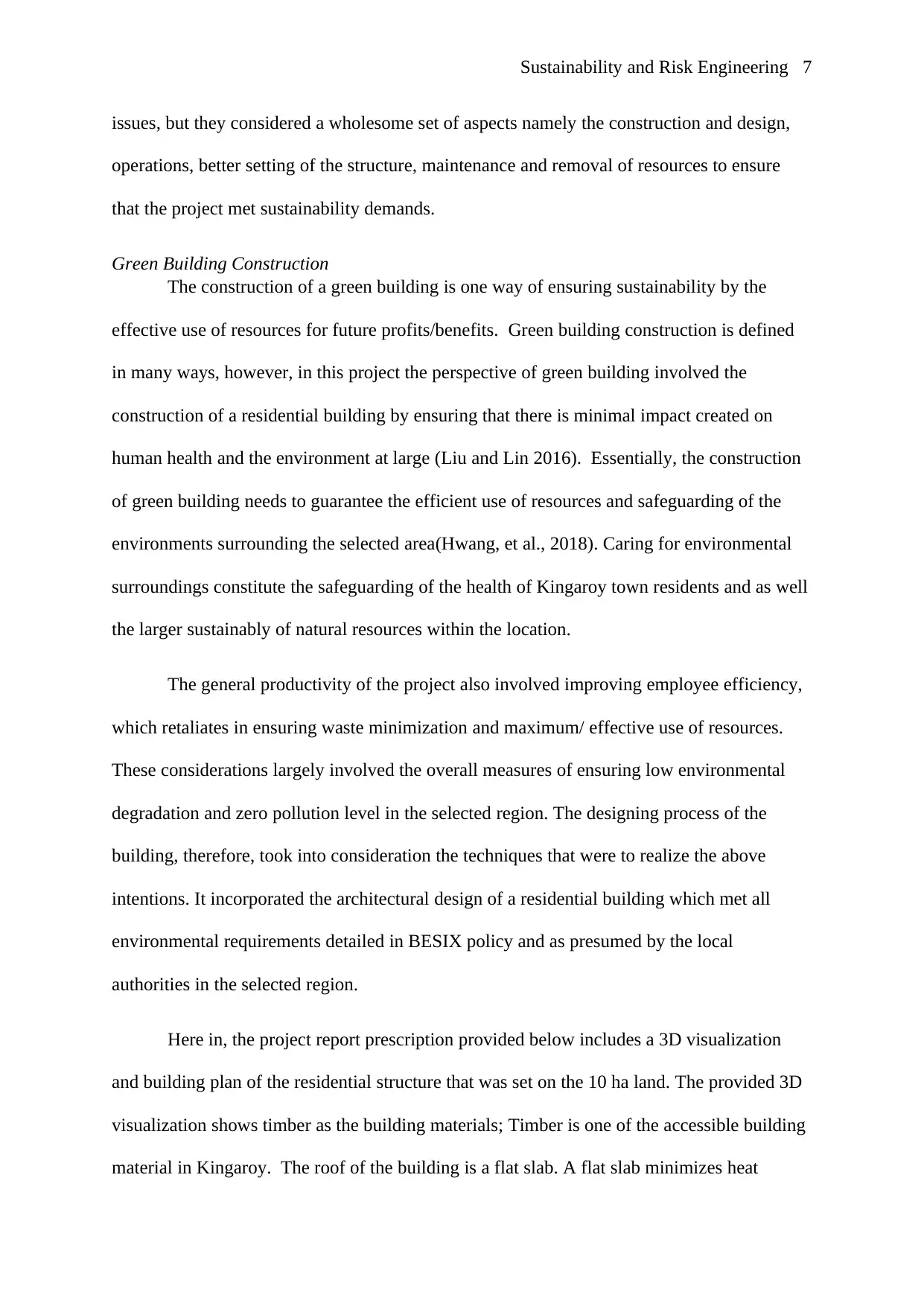
Sustainability and Risk Engineering 7
issues, but they considered a wholesome set of aspects namely the construction and design,
operations, better setting of the structure, maintenance and removal of resources to ensure
that the project met sustainability demands.
Green Building Construction
The construction of a green building is one way of ensuring sustainability by the
effective use of resources for future profits/benefits. Green building construction is defined
in many ways, however, in this project the perspective of green building involved the
construction of a residential building by ensuring that there is minimal impact created on
human health and the environment at large (Liu and Lin 2016). Essentially, the construction
of green building needs to guarantee the efficient use of resources and safeguarding of the
environments surrounding the selected area(Hwang, et al., 2018). Caring for environmental
surroundings constitute the safeguarding of the health of Kingaroy town residents and as well
the larger sustainably of natural resources within the location.
The general productivity of the project also involved improving employee efficiency,
which retaliates in ensuring waste minimization and maximum/ effective use of resources.
These considerations largely involved the overall measures of ensuring low environmental
degradation and zero pollution level in the selected region. The designing process of the
building, therefore, took into consideration the techniques that were to realize the above
intentions. It incorporated the architectural design of a residential building which met all
environmental requirements detailed in BESIX policy and as presumed by the local
authorities in the selected region.
Here in, the project report prescription provided below includes a 3D visualization
and building plan of the residential structure that was set on the 10 ha land. The provided 3D
visualization shows timber as the building materials; Timber is one of the accessible building
material in Kingaroy. The roof of the building is a flat slab. A flat slab minimizes heat
issues, but they considered a wholesome set of aspects namely the construction and design,
operations, better setting of the structure, maintenance and removal of resources to ensure
that the project met sustainability demands.
Green Building Construction
The construction of a green building is one way of ensuring sustainability by the
effective use of resources for future profits/benefits. Green building construction is defined
in many ways, however, in this project the perspective of green building involved the
construction of a residential building by ensuring that there is minimal impact created on
human health and the environment at large (Liu and Lin 2016). Essentially, the construction
of green building needs to guarantee the efficient use of resources and safeguarding of the
environments surrounding the selected area(Hwang, et al., 2018). Caring for environmental
surroundings constitute the safeguarding of the health of Kingaroy town residents and as well
the larger sustainably of natural resources within the location.
The general productivity of the project also involved improving employee efficiency,
which retaliates in ensuring waste minimization and maximum/ effective use of resources.
These considerations largely involved the overall measures of ensuring low environmental
degradation and zero pollution level in the selected region. The designing process of the
building, therefore, took into consideration the techniques that were to realize the above
intentions. It incorporated the architectural design of a residential building which met all
environmental requirements detailed in BESIX policy and as presumed by the local
authorities in the selected region.
Here in, the project report prescription provided below includes a 3D visualization
and building plan of the residential structure that was set on the 10 ha land. The provided 3D
visualization shows timber as the building materials; Timber is one of the accessible building
material in Kingaroy. The roof of the building is a flat slab. A flat slab minimizes heat
Paraphrase This Document
Need a fresh take? Get an instant paraphrase of this document with our AI Paraphraser
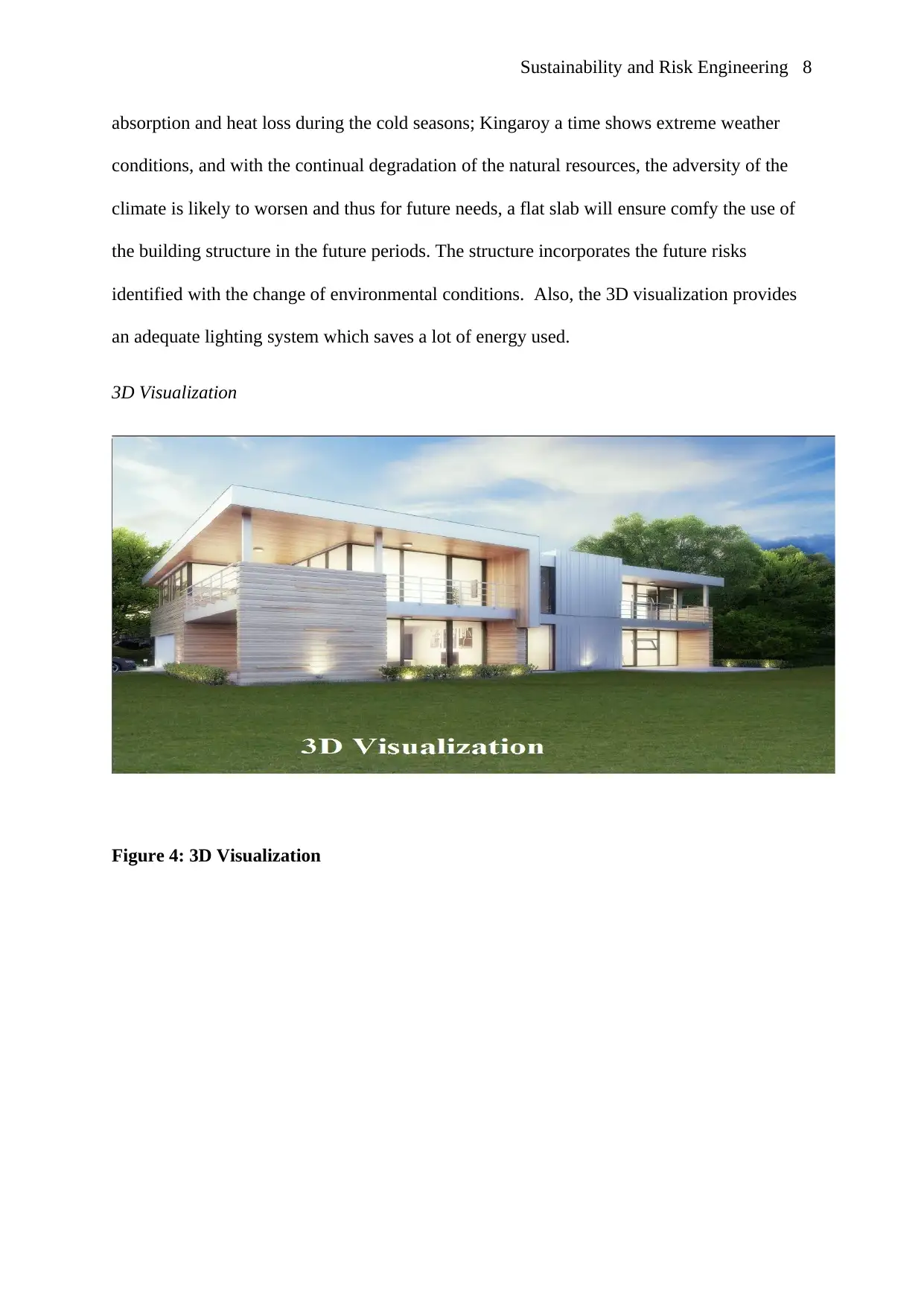
Sustainability and Risk Engineering 8
absorption and heat loss during the cold seasons; Kingaroy a time shows extreme weather
conditions, and with the continual degradation of the natural resources, the adversity of the
climate is likely to worsen and thus for future needs, a flat slab will ensure comfy the use of
the building structure in the future periods. The structure incorporates the future risks
identified with the change of environmental conditions. Also, the 3D visualization provides
an adequate lighting system which saves a lot of energy used.
3D Visualization
Figure 4: 3D Visualization
absorption and heat loss during the cold seasons; Kingaroy a time shows extreme weather
conditions, and with the continual degradation of the natural resources, the adversity of the
climate is likely to worsen and thus for future needs, a flat slab will ensure comfy the use of
the building structure in the future periods. The structure incorporates the future risks
identified with the change of environmental conditions. Also, the 3D visualization provides
an adequate lighting system which saves a lot of energy used.
3D Visualization
Figure 4: 3D Visualization

Sustainability and Risk Engineering 9
Figure 5: Ground Floor Plan
Figure 6: 1st Storey Plan
The residential structure internal formation constituted of a ground floor with a
balcony, a dining room, kitchen, a lounge, and a garage with a variable measurement that
provided for roomy living comfortability. The first story shows three bedrooms with spacious
passages. The use of the building was assumed to be reliant on other variable reasons one
being the sustainable longevity use and immediate profitable use with reduced risks, that is,
the average dead and live mass sustainability and also the durability of the used timber.
BESIX Report on the Building Structure
Figure 5: Ground Floor Plan
Figure 6: 1st Storey Plan
The residential structure internal formation constituted of a ground floor with a
balcony, a dining room, kitchen, a lounge, and a garage with a variable measurement that
provided for roomy living comfortability. The first story shows three bedrooms with spacious
passages. The use of the building was assumed to be reliant on other variable reasons one
being the sustainable longevity use and immediate profitable use with reduced risks, that is,
the average dead and live mass sustainability and also the durability of the used timber.
BESIX Report on the Building Structure
⊘ This is a preview!⊘
Do you want full access?
Subscribe today to unlock all pages.

Trusted by 1+ million students worldwide
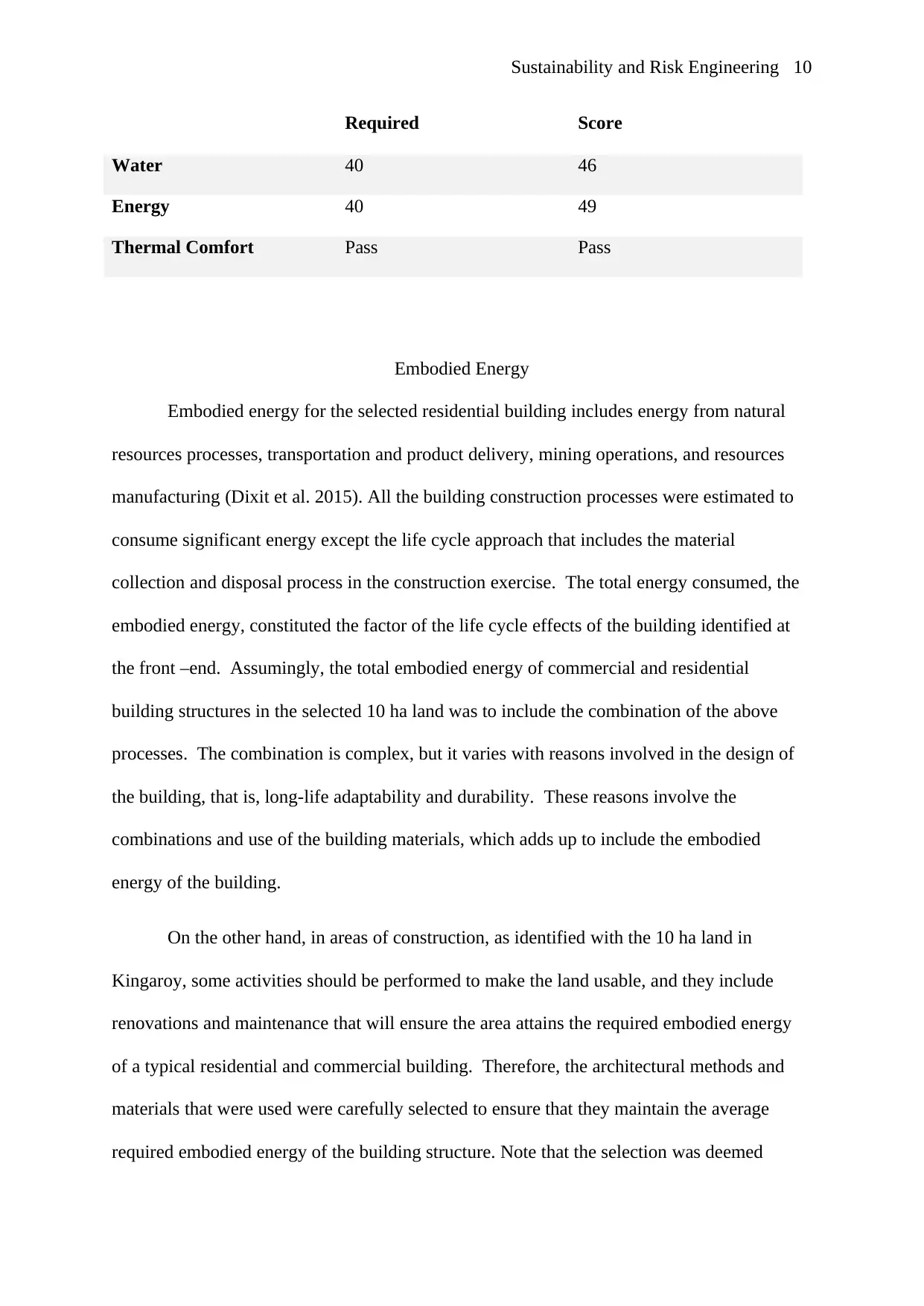
Sustainability and Risk Engineering 10
Required Score
Water 40 46
Energy 40 49
Thermal Comfort Pass Pass
Embodied Energy
Embodied energy for the selected residential building includes energy from natural
resources processes, transportation and product delivery, mining operations, and resources
manufacturing (Dixit et al. 2015). All the building construction processes were estimated to
consume significant energy except the life cycle approach that includes the material
collection and disposal process in the construction exercise. The total energy consumed, the
embodied energy, constituted the factor of the life cycle effects of the building identified at
the front –end. Assumingly, the total embodied energy of commercial and residential
building structures in the selected 10 ha land was to include the combination of the above
processes. The combination is complex, but it varies with reasons involved in the design of
the building, that is, long-life adaptability and durability. These reasons involve the
combinations and use of the building materials, which adds up to include the embodied
energy of the building.
On the other hand, in areas of construction, as identified with the 10 ha land in
Kingaroy, some activities should be performed to make the land usable, and they include
renovations and maintenance that will ensure the area attains the required embodied energy
of a typical residential and commercial building. Therefore, the architectural methods and
materials that were used were carefully selected to ensure that they maintain the average
required embodied energy of the building structure. Note that the selection was deemed
Required Score
Water 40 46
Energy 40 49
Thermal Comfort Pass Pass
Embodied Energy
Embodied energy for the selected residential building includes energy from natural
resources processes, transportation and product delivery, mining operations, and resources
manufacturing (Dixit et al. 2015). All the building construction processes were estimated to
consume significant energy except the life cycle approach that includes the material
collection and disposal process in the construction exercise. The total energy consumed, the
embodied energy, constituted the factor of the life cycle effects of the building identified at
the front –end. Assumingly, the total embodied energy of commercial and residential
building structures in the selected 10 ha land was to include the combination of the above
processes. The combination is complex, but it varies with reasons involved in the design of
the building, that is, long-life adaptability and durability. These reasons involve the
combinations and use of the building materials, which adds up to include the embodied
energy of the building.
On the other hand, in areas of construction, as identified with the 10 ha land in
Kingaroy, some activities should be performed to make the land usable, and they include
renovations and maintenance that will ensure the area attains the required embodied energy
of a typical residential and commercial building. Therefore, the architectural methods and
materials that were used were carefully selected to ensure that they maintain the average
required embodied energy of the building structure. Note that the selection was deemed
Paraphrase This Document
Need a fresh take? Get an instant paraphrase of this document with our AI Paraphraser
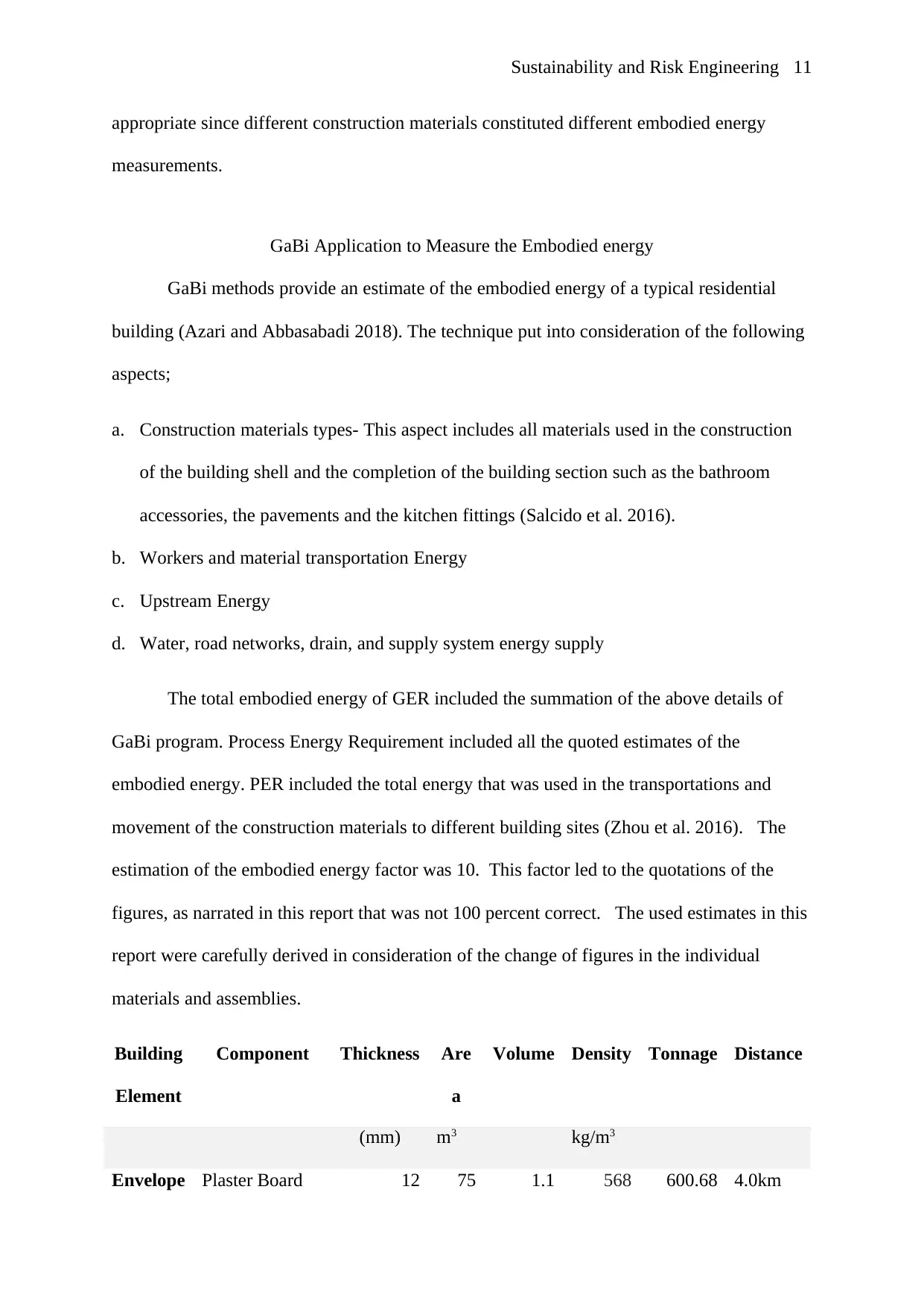
Sustainability and Risk Engineering 11
appropriate since different construction materials constituted different embodied energy
measurements.
GaBi Application to Measure the Embodied energy
GaBi methods provide an estimate of the embodied energy of a typical residential
building (Azari and Abbasabadi 2018). The technique put into consideration of the following
aspects;
a. Construction materials types- This aspect includes all materials used in the construction
of the building shell and the completion of the building section such as the bathroom
accessories, the pavements and the kitchen fittings (Salcido et al. 2016).
b. Workers and material transportation Energy
c. Upstream Energy
d. Water, road networks, drain, and supply system energy supply
The total embodied energy of GER included the summation of the above details of
GaBi program. Process Energy Requirement included all the quoted estimates of the
embodied energy. PER included the total energy that was used in the transportations and
movement of the construction materials to different building sites (Zhou et al. 2016). The
estimation of the embodied energy factor was 10. This factor led to the quotations of the
figures, as narrated in this report that was not 100 percent correct. The used estimates in this
report were carefully derived in consideration of the change of figures in the individual
materials and assemblies.
Building
Element
Component Thickness Are
a
Volume Density Tonnage Distance
(mm) m3 kg/m3
Envelope Plaster Board 12 75 1.1 568 600.68 4.0km
appropriate since different construction materials constituted different embodied energy
measurements.
GaBi Application to Measure the Embodied energy
GaBi methods provide an estimate of the embodied energy of a typical residential
building (Azari and Abbasabadi 2018). The technique put into consideration of the following
aspects;
a. Construction materials types- This aspect includes all materials used in the construction
of the building shell and the completion of the building section such as the bathroom
accessories, the pavements and the kitchen fittings (Salcido et al. 2016).
b. Workers and material transportation Energy
c. Upstream Energy
d. Water, road networks, drain, and supply system energy supply
The total embodied energy of GER included the summation of the above details of
GaBi program. Process Energy Requirement included all the quoted estimates of the
embodied energy. PER included the total energy that was used in the transportations and
movement of the construction materials to different building sites (Zhou et al. 2016). The
estimation of the embodied energy factor was 10. This factor led to the quotations of the
figures, as narrated in this report that was not 100 percent correct. The used estimates in this
report were carefully derived in consideration of the change of figures in the individual
materials and assemblies.
Building
Element
Component Thickness Are
a
Volume Density Tonnage Distance
(mm) m3 kg/m3
Envelope Plaster Board 12 75 1.1 568 600.68 4.0km
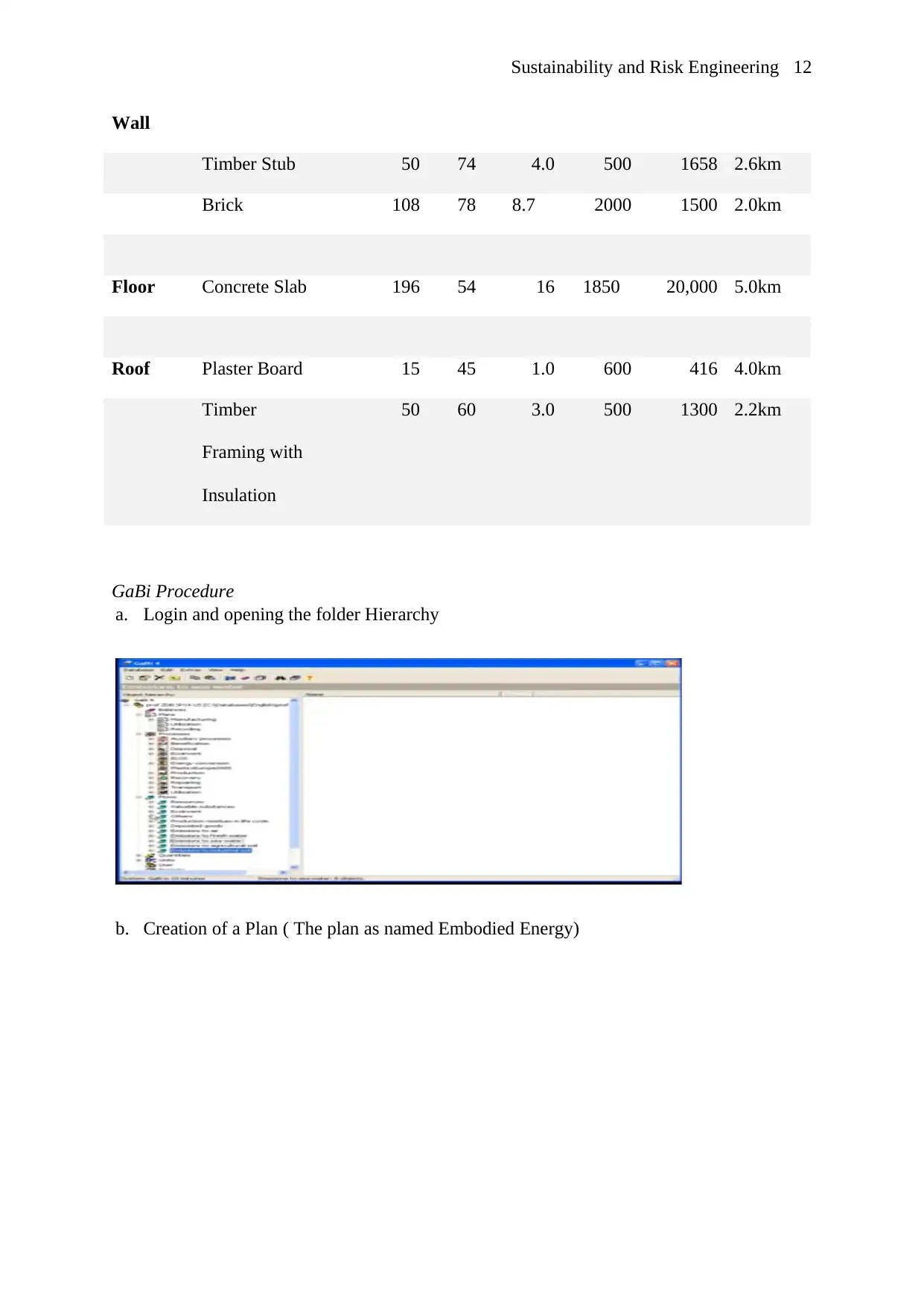
Sustainability and Risk Engineering 12
Wall
Timber Stub 50 74 4.0 500 1658 2.6km
Brick 108 78 8.7 2000 1500 2.0km
Floor Concrete Slab 196 54 16 1850 20,000 5.0km
Roof Plaster Board 15 45 1.0 600 416 4.0km
Timber
Framing with
Insulation
50 60 3.0 500 1300 2.2km
GaBi Procedure
a. Login and opening the folder Hierarchy
b. Creation of a Plan ( The plan as named Embodied Energy)
Wall
Timber Stub 50 74 4.0 500 1658 2.6km
Brick 108 78 8.7 2000 1500 2.0km
Floor Concrete Slab 196 54 16 1850 20,000 5.0km
Roof Plaster Board 15 45 1.0 600 416 4.0km
Timber
Framing with
Insulation
50 60 3.0 500 1300 2.2km
GaBi Procedure
a. Login and opening the folder Hierarchy
b. Creation of a Plan ( The plan as named Embodied Energy)
⊘ This is a preview!⊘
Do you want full access?
Subscribe today to unlock all pages.

Trusted by 1+ million students worldwide
1 out of 34
Related Documents
Your All-in-One AI-Powered Toolkit for Academic Success.
+13062052269
info@desklib.com
Available 24*7 on WhatsApp / Email
![[object Object]](/_next/static/media/star-bottom.7253800d.svg)
Unlock your academic potential
Copyright © 2020–2025 A2Z Services. All Rights Reserved. Developed and managed by ZUCOL.



